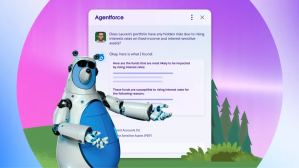Parker Harris Is on a Mission: “Just Because It’s Possible to Write Code, Doesn’t Mean You Should Write Code”


No one knows the Salesforce Platform like Parker Harris, Salesforce’s co-founder and Chief Technology Officer. For 22 years it’s been his focus.
And all these years later, his face still lights up when he talks about it. In between interview questions, chatting with a Salesforce employee who’s been learning more about the Platform, Harris smiles wide and raves, “Lightning rocks.” He’s talking, of course, about the Salesforce Lightning Platform which was introduced in 2014 and gave developers and admins a new way to interact with and build apps on Salesforce.
This afternoon Harris joins the call from his home office in San Francisco. Just over his shoulder is a tabletop collection of surfboard figurines emblazoned with ‘5’, ‘10’, ‘15’ and ‘20′ — awarded to Salesforce employees for years of service at the company, and evidently a mark of pride for Harris.
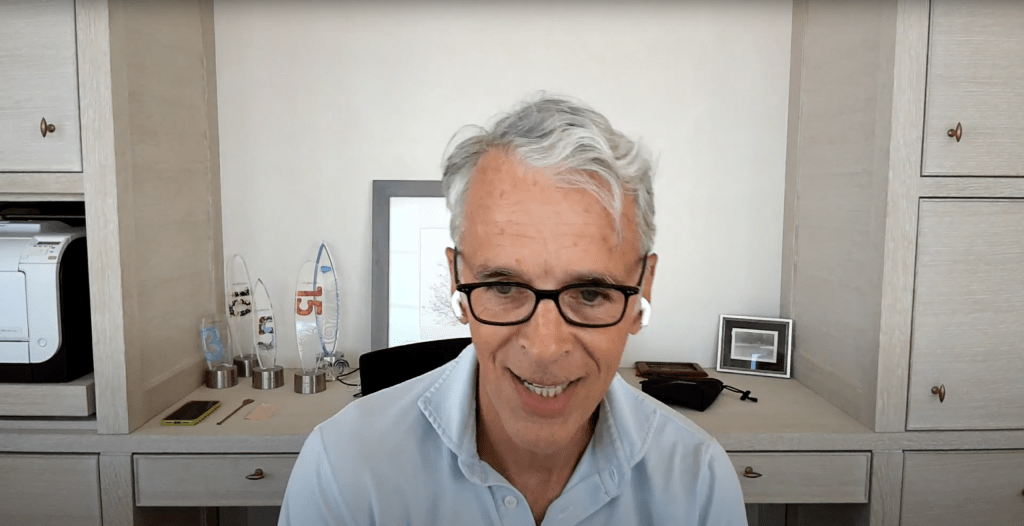
In two days, he’ll take center stage at TrailheaDX to share the latest news about the Platform.
Innovation in Salesforce’s platform continues at speed. The company has doubled down on low-code with recent announcements like Dynamic Interactions, and the massive launch of Hyperforce represents a reimagination of its platform on major public clouds.
Here, Harris shares his thoughts on the evolution of the Salesforce Platform over the last two decades, his vision for the future, and why he always celebrates the moment when a customer removes code from their Salesforce implementation.
Q: You’ve been co-founder and CTO of Salesforce for 22 years. What has changed the most in the software industry in that time?
You name it, pretty much everything has changed. We didn’t have the iPhone when Salesforce began. We didn’t have Facebook, we didn’t have Twitter. None of the social media platforms. We didn’t have the hyperscalers — companies like Amazon Web Services, Google Cloud Platform, Azure.
We started the company in ’99, and all of that has happened in the past 22 years.
When we started the company, people were reticent to put their credit cards on the internet, much less their customer lists. Many potential customers would say “There’s no way I’ll ever use you, because I would never put my customer list on the internet. It’s far too risky, it’s far too dangerous.” They felt safer having workloads in their own data centers.
What’s changed is they’ve found things are actually safer in these cloud providers, whose job it is, day in and day out, to protect customer information. That is a dramatic change.
Then if you look at what’s happened in this past year with everyone shuttered at home, everything has gone digital. We are doing this interview digitally online, we’re not physically together. Companies are selling virtually, doing customer service virtually.
Dell Technologies in a week sent all of their agents home. And because they’re using our platform, they were able to continue providing customer service to their customers. E-commerce is on fire. Everything is going faster and going even more digital right now.
Q: You made a huge bet on building a platform in the early days, and not just apps. Why did you make that decision?
It wasn’t really a decision, but something we felt we had to do when we started the company. We knew that we wanted to provide a service to as many customers as possible, all over the world.
It was hard to imagine where we are today, but we imagined a lot of customers, a lot of regions, a lot of different sized customers.
So, how in the world are we going to do that? How are we going to serve all of these customers?
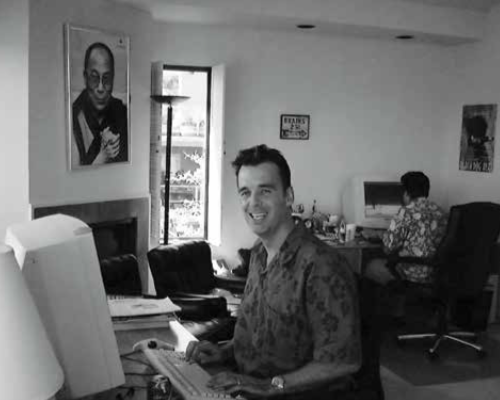
We needed to invent a metadata-driven platform that allowed us to have one set of software that could serve a small high-tech company here in the Bay Area, as well as non-high tech companies in the UK, in Australia, around the world.
Then we had a customer come to us that was in the healthcare business. And they said, “Hey, we’re in patient care. We don’t have accounts, we have hospitals. We don’t have contacts, we have patients. So we want to rename those tabs.”
“It’s all really in response to our customers, it’s what our customers asked us to do. And it’s what allowed us to deliver a service with trust and customer success, innovation and equality for the past 22 years.”
Parker Harris, co-founder and CTO, Salesforce
Initially, we thought “Well, just pretend that ‘account’ is the hospital!” But Marc [Benioff, Salesforce’s co-founder and CEO] said, “No, we’ll support that.”
So we allowed you to change the names of tabs. We allow you to create your own tables or custom objects. We added workflow capability.
It’s all really in response to our customers, it’s what our customers asked us to do. And it’s what allowed us to deliver a service with trust and customer success, innovation and equality for the past 22 years.
Q: Why is the speed and flexibility that the Platform enables so important right now?
Look at Work.com. Work.com was not even an idea when the pandemic started. But we looked around and we realized “Whoa, everyone’s at home!”
So we started asking questions. First, how can we help people do contact tracing? How are we going to support all those people working from home? How can we help them eventually get back into the office as things start to reopen? How can our platform support that?
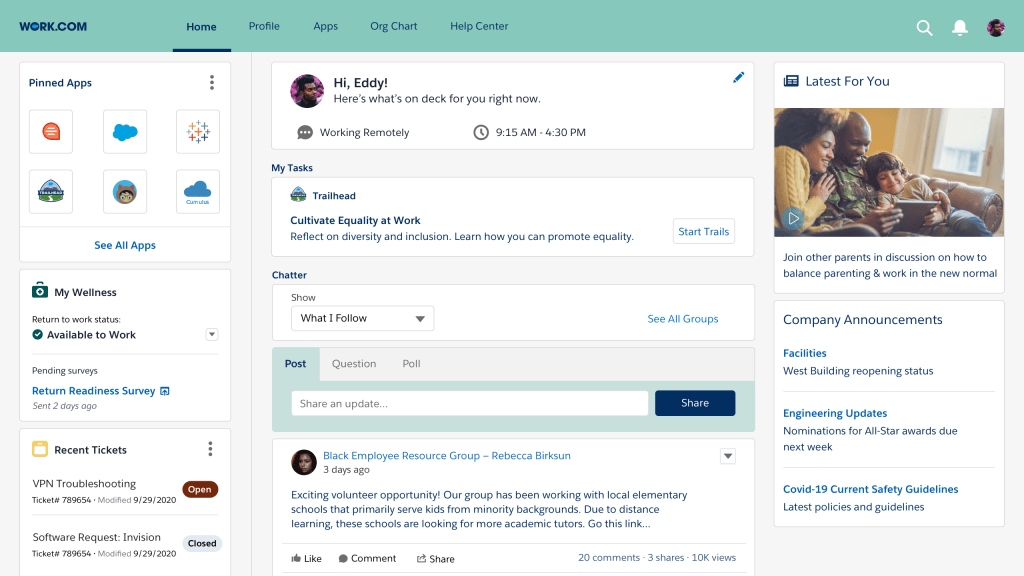
That led us to Work.com. In the middle of the pandemic we took some teams and said we need a brand new product, and we need it now. That would have been impossible without the power of our platform, because they didn’t have to go write code from scratch.
They just took our platform and pivoted quickly, and came out with a new offering called Work.com that does all of those things. We built Work.com in 6 weeks, from concept to launch.
Q: One of the reasons that the Work.com team didn’t have to write code from scratch is that low-code tools are at the core of the Salesforce Platform. In a world where there is so much digital transformation happening, so quickly, low code becomes incredibly powerful. Why has low code been core to the Salesforce Platform for so long?
Salesforce started out with only low code. That’s all you could do. You could change the name of a tab. You could add some additional fields to your objects or tables that you wanted to track information. But over time we added the support for code. We added Apex. We added Workflow, we added Visualforce to write code, to do user experience. That then evolved into Lightning and Lightning Web Components today, which is state-of-the-art.
We always like to say that we make the simple things simple and the hard things possible. But what I think is missing in that, that we have to really hit home, is that just because it’s possible to write code, doesn’t mean you should write code.
“In the middle of the pandemic we took some teams and said we need a brand new product, and we need it now. That would have been impossible without the power of our platform, because they didn’t have to go write code from scratch.”
Parker Harris, co-founder and CTO, Salesforce
We’re on a mission now with all of our customers. We believe that low-code is the future. I always celebrate the moment when we remove code from our code base, or when a customer removes code from their implementation.
I don’t care what platform or what technology you’re talking about. Code has inertia, it has gravity, and it has a cost. The less you can put into your product and put into your implementations, the better.
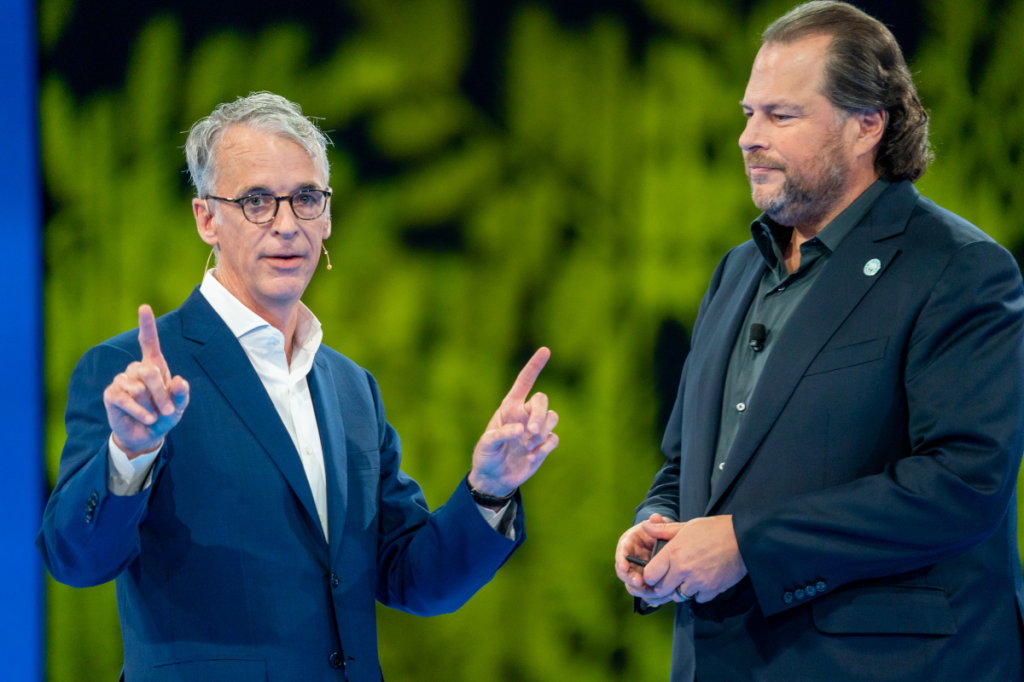
Low code was the power behind getting Work.com and Vaccine Cloud off the ground. Eighty-three percent of IT leaders today plan to increase their use of low-code development tools.
“I don’t care what platform or what technology you’re talking about. Code has inertia, it has gravity, and it has a cost. The less you can put into your product and put into your implementations, the better.”
Parker Harris, co-founder and CTO, Salesforce
And we are the premier platform for low-code development. That’s why I’m so excited for TrailheaDX to show off some of the new capabilities that we have [Editor’s Note: TrailheaDX takes place on 23rd June, with Parker Harris’ keynote kicking off at 9am Pacific time. You can watch the keynote here.]
Q: What’s your vision for the future of the Salesforce Platform over the next two to five years?
First, we’re baking more and more security, compliance and trust into the platform. A lot of that is through Hyperforce, which is our move to the public cloud.
Hyperforce lets us solve data residency concerns. When customers say “I want my data in France,” Hyperforce enables that easily and quickly.
Hyperforce means we can take our system and run it pretty much anywhere in the world — and importantly, do so at scale. Everyone is a B2C company in this new digital world that we’re in. Everyone is hitting B2C scale challenges, and our platform is supporting that.
Second, we host so much data for our customers. We want to keep giving more value back to those customers. Our Customer Data Platform allows you to bring all of the data that we host for you together, but also other data assets you might have in your organization.
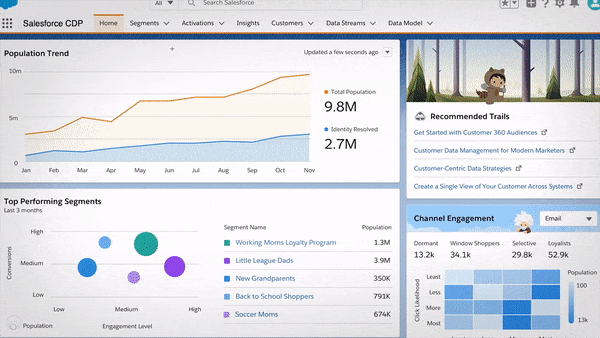
We bring that data together on a scalable, secure, and trusted platform that you can then activate. To go send your emails, send SMSes, see a 360-degree view of every one of those consumers.
It’s an immediate and always up-to-date 360 degree view – not as of a month ago, but as of five seconds ago when that consumer hit your website or opened your mobile app, or entered your physical store.
Those are the little digital signals that — assuming that consumer is giving you the right to use that information, because privacy is also baked into this platform — help you give them a better customer experience, whether you’re buying something or you need customer service, or you’re receiving a marketing email about things you might be interested in.
“Everyone is a B2C company in this new digital world that we’re in. Everyone is hitting B2C scale challenges, and our platform is supporting that.”
Parker Harris, co-founder and CTO, Salesforce
Everyone’s trying to figure out how to get data together and analyze it. But the problem is not just bringing it together and analyzing it, it’s to activate it, to do something with it.
I couldn’t be more excited about that direction. It’s really all about the Customer 360 and all of those touch points, and doing it at hyper scale and in real time.
To listen to more from Parker Harris, check out the interview on the Blazing Trails podcast, below:














